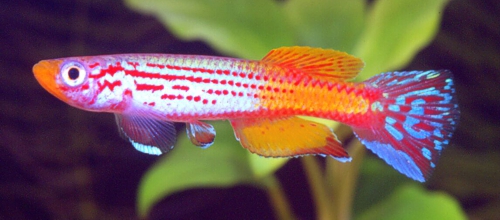Aphyosemion halleri Radda & Pürzl 1976

Billi. Photo Courtesy of Ed Pürzl
| Meaning of Name |
After Ernst Haller of Stuttgart co-collector (with Radda & Pürzl) of the species. |
|||
| First Description |
Radda A.C. & Pürzl 1976. Der Aphyosemion cameronense Komplex. DKG Journal 8 (11): 138-140. |
|||
| Size |
4.5 cm |
|||
| Meristics |
D = 12, A = 16, D/A = 1/7, ll = 32 + 2. |
|||
| Karyotype |
|
|||
| Sub-Genus |
Mesoaphyosemion |
|||
| Group |
A.cameronense |
|||
| Synonyms |
Aphyosemion cameronense halleri Radda 1976. |
|||
Populations
|
Bac Eking - This was the locality mentioned by Radda & Pürzl in 1976 where they collected at the time of Haller's collection in Ambam. There is no information on exact distances as the road between the ferry (Bac Eking) & Ambam is 29kms. Bikong (Bikon) - http://www.nakashima.org/ga_ca_hal_b.htm Japan Gallery. Amiet mentions this location in his 1987 book as being a small village about 3kms north of Ambam on the road to Ebolowa. Streams from here eventually drain into the Ntem River. EMS 90/6 - Near Bikong. Collected 17th August 1990 at about 3pm. Stream was 50 cm wide & 20 cm deep. Also collected small fish of the A.herzogi group. Water temperature around 24°C. Water was slow flowing & clear with a muddy bottom. Distributed as Bikong. EMS 90/7 - Situated 400 metres south of the Catholic Mission in Ambam. Collected 17th August 1990 at about 12 noon. Stream was about 1 metre wide & 20 cm deep. Distributed as Ambam. A.halleri was the only species collected. GBL 85/17 - Stream 5kms north of the Ferme Agricole, Bitam on the road to Eboro & the border with Gabon/Cameroon. Also collected an Epiplatys (probably E.neumanni). Not brought back to the hobby. GBL 85/18 - About 1·5kms north of the intersection of the Bitam - Eboro & Bitam - Minvoul roads on the way to Eboro & Cameroon border. same location as PEG 94/29. GBL 85/21 - Near the village of Billy (Biyi) about 1km west of the turning to Ebébiyin off the Bitam to Eboro road. Distributed in the hobby as Billy. Same location as PEG 94/31. GBL 85/22, 23, 24 & 25 - None of these were distributed in the hobby. Collected 2·5 to 11kms west of the crossroads to Ebébiyin. PEG 94/31 - Collected on 16th August 1994 at about 1pm. A stream crossing the road which was mentioned by Bardon & Lombard (GBL 85). No killies found in the washing area here. Went 500 metres upstream where large numbers of A.halleri (brought back to Europe) were found along with small barbs & a Ctenopoma sp. PEG 94/32 - Near the village of Oveng Mélén, 9kms west of the turning to Ebébiyin to Billy. The forest stream south of the road is called the Mvézé by villagers (also the name of the small river running parallel to the Ebébiyin to Billy road in a northwesterly direction. The biotope was drying up into pools trickling downstream through the mud. Collected in large numbers (adult & half grown) but not returned to Europe. |
|||
| Type Locality |
A spring supplying the water for the Catholic Mission post of Ambam. Collected on 7th December 1975. Ambam is a border town with Cameroon & Gabon. The stream at this Mission is called Bitutui which eventually drains into the Ntem River. |
|||
| Distribution |
The area of Ambam, south west Gabon for sure. More collecting trips are needed to fully discover the distribution area. |
|||
| Habitat |
Rainforest streams |
|||
| Distinguishing Characteristics | Heavy orange area from the caudal peduncle extending down almost half the body. A.amoenum has this orange area on the caudal peduncle but this does not extend as far down the body. A.halleri has an orange mouth area which is absent in A.amoenum. A.halleri has pale blue outer margins (at least in the photos I have seen). In A.amoenum this is yellow (in most specimens but can appear as pale blue). | |||
| Colour/Pattern Variability | In the photos I have seen of this species the body seems similar. One major area which can be variable is the anal fin which can be clear or have vertical red lines. | |||
| History |
First discovered by Ernst Haller at the Catholic
Mission post of Ambam, southwest Cameroon. Haller was part of the Radda
& Pürzl 1975 trip but due to a ferry breaking down Haller was
forced to stay with the hire car in Ambam. On the same day Radda &
Pürzl collected this species in another location between the ferry
across the Ntem & Ambam. Amieti in his 1987 book reports this species to the north of the type locality. The species was found near Bikon. August 1990 Eberl et al collected near the Catholic Misssion in Ambam (probably the same location as Haller in 1975). In this case the location code was EMS 90/7. The place where Amiet collected (Bikon - Bikong & north of the type locality) was revisited. August 1994 Passaro & Eberl collected them around Bitam in north Gabon. Live fish were brought back to Europe. |
|||
| Breeding Notes |
Reports suggest this species is not difficult to breed. Fry are not harmed by the parents & can be left with them until old enough to be netted out into their own tank for raising. |
|||
| Diameter of Egg | ||||
| Remarks |
Young fish grow on slowly & can take 8 months to reach sexual maturity. |